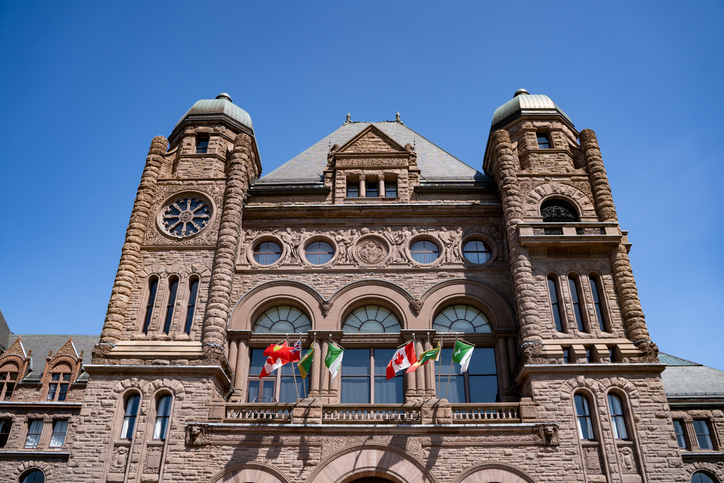In part one of our two-part blog, we noted some of the “hot” issues that face the Ford government in this legislative session and stated that health care would be a “shield” issue – something that the government will be forced to play defense on – and that Ford’s team would tread cautiously. Well, so much for that analysis! Health care may still be a “shield” issue, but Ford has already – before the Legislature has convened – made a bold move that will surely shake up the political calculus for this session.
This morning, the Ford government appointed former Federal Liberal Health Minister (and now Dean of the Queen’s University School of Medicine) Dr. Jane Philpott to chair a new “Primary Care Action Team” with the audacious goal of ensuring every Ontarian is connected to a primary care provider within five years.
This initiative has implications in both policy and politics. There were loud rumours – backed by quotes directly from Dr. Philpott – that suggested she was considering running for the Ontario Liberals as a “star” candidate in the next election. Just a month ago, she told a CBC interviewer that “if a door ever opened that was the right one, that would allow me to go back into a political role, I would certainly consider it.” In that same interview she said: “It’s possible that might involve a role in government some day, but I’m still exploring what that might look like.” She was also the keynote speaker at the Ontario Liberal Party policy convention and made it seem to everyone that she was ready to run again. Well, she made the choice and chose – at least for now – not to take the political route. It is reasonable to assume that Ontario Liberal leader Bonnie Crombie and her team are disappointed.
Philpott’s communication this morning has been careful to say that she is joining the Ontario Public Service and not taking a political role, so the door remains open for her – at least a crack.
https://x.com/janephilpott/status/1848356955749859717
As of Dec 1 I’m taking a role with Ontario Public Service to chair a small but mighty team tasked with primary care reform, to make sure everyone in Ontario is attached to a family doctor or NP providing ongoing comprehensive care in a publicly funded team
Regardless of Dr. Philpott’s political future, the implications for the Ontario PCs may be even more profound. In the pantheon of issues, there are “sword” and “shield” issues: topics that you want to play offense or defense on. In a single stroke, Ford is making an effort to erect the biggest shield he can find on health care. He hasn’t made himself entirely immune to criticism, but he has made it a lot harder for his opponents – especially from the Liberals – to land that criticism with any force, particularly with one of “their own” leading the effort.
From a policy perspective, appointing this “Action Team” and giving it a 5-year goal focuses the policy apparatus of government around this goal – while buying time well beyond the immediate election cycle. Ford’s government has already announced new medical schools and other measures, such as scope of practice changes for pharmacists and nurse practitioners, which will have a positive impact, but these changes take time to take root. Whatever Dr. Philpott can do to further focus the system will be welcomed, especially by those Ontarians who are presently not connected to a primary care physician.
Continuing the theme of “bold” moves made by the Premier in recent weeks, the other big initiative that is sure to get a lot of attention at Queen’s Park, is the announcement from a few weeks ago that the province is going to conduct a technical review of various options to expand highway capacity in the Greater Toronto Area, including the construction of a proposed new tunnel under Highway 401.
While the tunnel announcement was met with considerable skepticism and widespread teasing from many quarters, in our view it reflects a desire by the Premier to be seen as a transformative leader with an ambition to do big things on “nuts and bolts” issues. He wants to live up to the slogan: “Only Doug Ford can get it done”.
To no surprise, this type of out-of-the-box thinking was met with ridicule from exactly the kinds of people who have underestimated Doug Ford for his entire political career. He will ignore them, because he believes that allowing others to talk him out of doing the hard but necessary things is what led to the problems Ford inherited that should have been fixed long ago. The government argues that it is proposing big solutions because the problems they face are big – in part due to deferrals by past governments. In this instance, massive population increases will continue to put stress on GTA highways, which are expected to be at capacity within ten years.
Premier Ford has consistently demonstrated a fondness for infrastructure investment as a signature of his government – and he has some success to show for it. While the Ford government inherited the continuing saga of the Eglinton-Crosstown LRT, progress to date on the Premier’s Ontario Line subway is impressive and planning for the construction of the Bradford Bypass highway is well underway.
The true genius of the tunnel plan may be in the politics of the plan and the problem it causes the other parties and their leaders. If they choose to ridicule the plan, the question will turn to them: so, what’s your plan? Whatever they put forward will look like a half-measure in comparison. The tunnel plan also buys Ford and the PCs more goodwill from car-commuting voters (a crucial demographic that is key to Ford’s voter coalition) who will forgive them for projects that take a little longer – as infrastructure projects inevitably do – and for the cost overruns that will inevitably follow. The solution to ending gridlock in the GTA is probably not one big thing, but hundreds of smaller projects and initiatives that will take time … time that Ford might have bought himself.
This session, the Ford government will make their closing arguments to Ontario voters on why they are the party best equipped to tackle these very real challenges and lead the province for the foreseeable future. This will be a highly tactical exercise in compare and contrast. Every big and bold idea rejected or scorned by the opposition will be met with questions about what their proposed alternative is.
The Ford government has a significant legislative agenda planned for the fall session that will aim to accomplish two things. First, create shields where the most complicated, ongoing challenges (like healthcare and housing) are being addressed, knowing these will be hot button issues during the next election, and a potential vulnerability for the government with voters it needs. Second, reinforcing and delivering on areas where Ontario has an opportunity to be a North American leader, including transportation, justice reform, and energy transition.
The Legislative Agenda
Some of the rumoured legislative plans include:
- Transportation. Late this summer, the government began beating the drum about bike lanes in cities, and the Premier made comments that the government is planning on “really game-changing things that we’re going to do in transportation.” Touted to include restrictions for municipalities introducing bike lanes, raising highway speed limits, freezing knowledge and road test fees, and fixing potholes. This is headline legislation for the Premier who has made tackling gridlock and “getting drivers and commuters out of traffic” an election issue.
- Energy and Electrification. The government is pushing to expand the power grid and address the growing demand for power in the province – a 75 per cent increase expected by 2050, according to the IESO. This will likely include new measures to streamline the planning and construction of powerlines and energy infrastructure as well as to respond to demand changes that are expected to emerge from increasing electrification of the economy. Attracting investment from high-energy demand industries, such as green steel production (using electric arc furnaces, instead of burning coal), electric vehicle production, and data centres will also continue.
- Justice and Crime Prevention. Crime continues to be a hot button issue for many Ontarians. Even though auto theft numbers are starting to decline in absolute numbers, many Ontarians continue to feel that auto theft remains a pressing problem. Same with rates of violent crime and many property crimes. The numbers may show that Ontarians are living in a safer place, but the perception is that we face more crime and lawlessness, and that perception is exacerbated by the seemingly senseless situation where the crimes are often committed by criminals out of jail on bail or probation.
Criminal justice issues are a joint responsibility of the provincial and federal governments, with the federal government setting the rules in the Criminal Code and the province administering police, courts, and jails. Notwithstanding this bright line of jurisdiction, watch for the Ford government to bring forward new initiatives to address crime as well as to put pressure on the federal government.
- Cybersecurity. The government may introduce follow up legislation to their earlier cybersecurity legislation, Bill 194, Strengthening Cyber Security and Building Trust in the Public Sector Act, from May. This new legislation will likely focus on the private sector and align with previous measures by the government for digital modernization in Ontario.
- Red Tape Reduction. We expect another bundle of minor changes to improve quality of life for businesses and streamline interaction with government.
- In light of the potential early election next year, the 2024 Fall Economic Statement (scheduled for October 30th) will take on outsized importance for campaign prognosticators. Fall economic statements, like budgets, are an opportunity for governments to return to core messaging and emphasize why they are the best to solve the issues of the day, while lighter on substantive new policies than a budget. The top messages in the Finance Minister’s speech and any new policies within the Statement will be key cues for what the government’s priorities are for the next year.
Opposition
With the PC Party well ahead in the polls, the opposition parties must establish a compelling narrative that describes why Ontarians should vote for them – and equally important – why voters should choose them and not another party.
One of the biggest challenges for the opposition right now is that voters are relatively unfamiliar with their leaders, or what plan they are proposing that distinguishes them both from the Ford government and each other. Thus far, the opposition has largely relied upon “not being Doug Ford” as their defining characteristic. In a time where Ford’s “for the people” brand of politics has proven enduringly popular with a critical mass of voters, branding your party solely as the antithesis of it only goes so far. The opposition parties need to use what remaining time they have left before the Premier calls an election to convince voters that a Liberal, NDP, or Green government is more capable of leading Ontario than the Ford PCs.
Despite their best efforts this fall, the opposition parties’ success or failure won’t be decided by their performance in the majority legislature – it will depend upon their ability to raise money, establish a compelling narrative, and mobilize their supporters. While this election isn’t shaping up to be a “change election,” it has the potential to reshape the standings of parties in the House.
Expect to see Bonnie Crombie’s Liberals echoing their “more for you” narrative, asserting that a Liberal government would invest in more of the services that voters and their families rely on. Crombie has an uphill battle despite her name recognition in the GTA, as the PCs heavy rotation attack ads against the Liberal leader impacts her ability to brand herself.
The Liberal brand in Ontario is also suffering through association with the unpopularity of the Trudeau government in Ottawa, providing the Ontario NDP with an opportunity to cement itself as the most viable option for progressive voters. As the Official Opposition, the NDP can use the legislature more effectively, opposing the government and relying on their size as evidence that they are the closest party to dethroning Ford and taking over. The NDP is finally getting around to introducing its leader through advertising but has thus far struggled to find a cohesive message and demonstrate stability as they have dealt with various caucus divisions. Another challenge is defections to Ottawa: three prominent NDP MPPs have recently announced their intent to run federally.
The Greens are only two MPPs strong but have effectively employed their comparatively limited resources to lead the opposition parties on policy, tabling multiple pieces of legislation and using the legislative media room to promote ideas and challenge the Ford government on a regular basis. For that, they get rewarded with coverage well beyond their seat count, which is expected to continue through the fall session.
What this means for Counsel’s clients
With an election on the horizon, the coming session is all about positioning and trying to set forth the best narrative for voters. The opposition parties will be hungry for signs of scandal, government mismanagement or lack of compassion that they can exploit. All parties will be looking out for vote-getting ideas that fit with their message and will be more apt than usual to embrace bold, out-of-the-box thinking in their platforms.
This is a good time for organizations to consider how they can best activate supporters to have an impact in a pre-election environment. As pre-election activities begin, candidates will be out knocking on doors and looking to speak directly to the voters. Identifying MPPs and would-be MPPs who are sympathetic to what you are trying to achieve and willing to help within their party caucus can be a catalyst for any government relations campaign. Efforts to effectively activate your grassroots supporters will become increasingly important in the coming months.
Companies or associations looking to engage government must be hyper-aware of the immense pressure everyone is under in a pre-election period. Whatever you have to say, say it fast; say it with a punchy message that lands quickly and say it loudly over the din of all the other voices clamouring for attention. At Counsel, we’re experienced in getting your message heard by cutting through the clutter.
If you’re interested in learning more about effective grassroots and platform engagement, contact Counsel’s Ontario team:
Michael Ras
Senior Vice President
mras@counselpa.com
Devan Sommerville
Vice President
dsommerville@counselpa.com
Rob Elliott
Associate Vice President
relliott@counselpa.com
Johanna Chevalier
Associate Vice President
jchevalier@counselpa.com
Felix Burns
Account Director
fburns@counselpa.com
Meera Mahadeo
Senior Consultant
mmahadeo@counselpa.com
Shawn Cruz
Senior Consultant
scruz@counselpa.com








